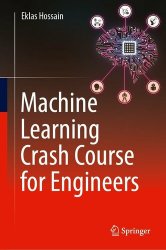Machine Learning Crash Course for Engineers
- Добавил: literator
- Дата: 27-12-2023, 18:24
- Комментариев: 0
 Название: Machine Learning Crash Course for Engineers
Название: Machine Learning Crash Course for EngineersАвтор: Eklas Hossain
Издательство: Springer
Год: 2024
Страниц: 465
Язык: английский
Формат: pdf
Размер: 12.7 MB
Machine Learning Crash Course for Engineers is a reader-friendly introductory guide to Machine Learning algorithms and techniques for students, engineers, and other busy technical professionals. The book focuses on the application aspects of Machine Learning, progressing from the basics to advanced topics systematically from theory to applications and worked-out Python programming examples. It offers highly illustrated, step-by-step demonstrations that allow readers to implement Machine Learning models to solve real-world problems. This powerful tutorial is an excellent resource for those who need to acquire a solid foundational understanding of Machine Learning quickly.
There are numerous books on Machine Learning out there. So why do we need another one in this field? What does this book offer that other similar books do not have? A reader has the right to ask such questions. Furthermore, as an author, I am obliged to make my stand clear about writing a crash course book on Machine Learning.
This book is a crash course, delivering only what engineers need to know about Machine Learning to apply in their specialized domains. The book focuses more on applications and slightly less on the theory to cater to the needs of people in non-programming majors. The first three chapters are concept-building chapters, where the basics are discussed with relevant programming examples. In my opinion, the true beauty of this book lies in the following three chapters, where the applications of Machine Learning in signal processing, energy systems, and robotics are elaborately discussed with some interesting examples. The final chapter talks about state-of-the-art technologies in Machine Learning and artificial intelligence and their endless future possibilities.
Overall, this book delivers a complete Machine Learning package for engineers, covering common concepts such as convolutional neural networks (CNN), long short-term memory (LSTM), natural language processing (NLP), load forecasting, generative adversarial networks (GAN), transfer learning, and many more. Students are welcome to reuse, reproduce, and utilize the programming examples in this book for their projects, theses, and any other work related to academic and research activities. I believe this book can help students develop ideas, formulate projects, and draw conclusions from their research. If students find this book helpful, only then can I consider this book a successful endeavor.
If anyone wants to learn Machine Learning from scratch, this book can only be a supporting tool for them. However, to learn basic programming and algorithmic concepts, one should primarily refer to a more fundamental book that covers detailed theories. Nevertheless, this book is for students, researchers, academicians, and industry professionals who would like to study the various practical aspects of Machine Learning and keep themselves updated on the advances in this field. Beginners might require a significant amount of time to understand the book. If the readers have a clear concept of the basics of mathematics, logic, engineering, and programming, they will enjoy the book more and understand it better. The intermediate-level readers will require less time, and advanced readers can complete the book in a week or so. A long time of about three years has been invested into the making of this book. As such, some old datasets have been used, but the information on the latest technologies, such as ChatGPT, EfficientNet, YOLO, etc., is included in the book.
Python and R are the two most highly used programming languages for developing ML programs. Python will be used as the only programming language in all examples of this book due to its ease of use, popularity, and the large, friendly, helpful, and interactive community Python encompasses. It is open-source, highly used in academic and research-based works, and is recommended by experts in almost every field. It is very efficient in terms of the amount of code needed to be written. The short, simple lines of Python code with obvious implications can be easily handled by beginners and are easy to read, debug, and expand. Python is also a cross-platform programming language, implying that it can run well on all operating systems and computers. Python has often been nicknamed the Swiss army knife of programming languages because of its versatile nature and a wide range of functionalities. It contains many packages that can cater to almost all possible applications. The most used ML libraries are NumPy, Pandas, Scipy, Theano, Keras, Scikit-learn, Matplotlib, etc., while the most common frameworks are PyTorch and TensorFlow.
Скачать Machine Learning Crash Course for Engineers
[related-news] [/related-news]
Внимание
Уважаемый посетитель, Вы зашли на сайт как незарегистрированный пользователь.
Мы рекомендуем Вам зарегистрироваться либо войти на сайт под своим именем.
Уважаемый посетитель, Вы зашли на сайт как незарегистрированный пользователь.
Мы рекомендуем Вам зарегистрироваться либо войти на сайт под своим именем.
